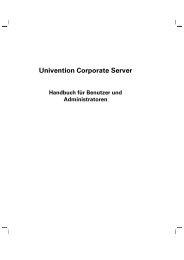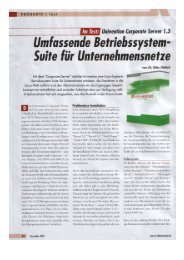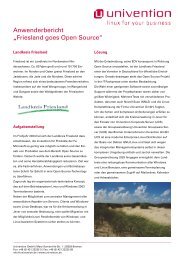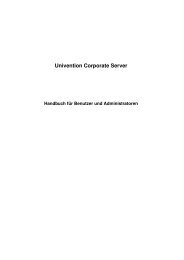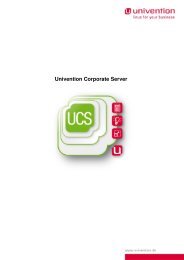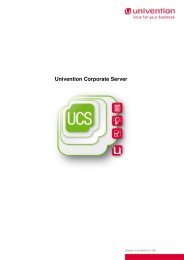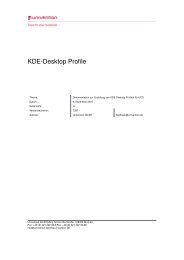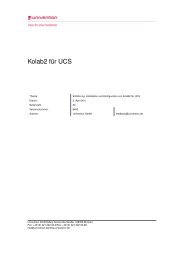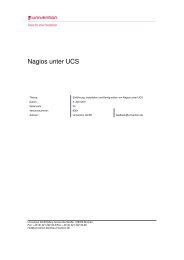UCS 2.4 - Univention
UCS 2.4 - Univention
UCS 2.4 - Univention
Create successful ePaper yourself
Turn your PDF publications into a flip-book with our unique Google optimized e-Paper software.
8.4 Extended Configuration<br />
System policies have to be stored in a Windows or Samba domain in the NETLOGON share and have to<br />
be named ntconfig.pol.<br />
8.4.4 Creating objects in the LDAP directory using Samba<br />
If user or group accounts are created in a Samba domain or a Windows computer joins the domain, these<br />
data are entered in the LDAP directory via Samba.<br />
To do this, initially it is checked if an object with the same name already exists in the LDAP directory. These<br />
existing objects will be adapted to the new data.<br />
If the objects do not yet exist in the LDAP directory, the accounts are created in stan-<br />
dard containers. These standard container can be determined with the <strong>Univention</strong> Configura-<br />
tion Registry variables samba/defaultcontainer/user, samba/defaultcontainer/group and<br />
samba/defaultcontainer/computer. The full DN of the container in question must be used. For<br />
example, if the <strong>Univention</strong> Configuration Registry variable samba/defaultcontainer/group is config-<br />
ured to the cn=windows-groups,cn=groups,dc=firma,dc=com container using <strong>Univention</strong> Management<br />
Console, this becomes the standard container for group accounts. The variables can contain differing val-<br />
ues on different Samba servers. In this way, for example, computers at location 1 can be stored in a differ-<br />
ent container from computers at location 2. If these variable are not set, the containers cn=users,, cn=groups, and cn=computers, are used.<br />
When NT user accounts are imported, the standard containers are used of the server on which the migra-<br />
tion script is run. Existing objects are described in more detail in the migration documentation [15].<br />
8.4.5 Configuring Windows user accounts<br />
Settings which are to be valid for all the Windows user accounts, are made in the Samba configuration.<br />
This configuration consists of the file /etc/samba/smb.conf and the files integrated therein. Many<br />
parameters of the Samba configuration can be set via the <strong>Univention</strong> Configuration Registry variables.<br />
Where several servers are in use, the Samba configuration applicable for each user is that one which<br />
belongs to the server against which the user is authenticated. User-specific settings can be defined via<br />
the menu <strong>Univention</strong> Directory Manager ➞ Add/Find Users ➞ Windows<br />
UNIX directories which are to be used under Windows, have to be set up as Samba shares (see chapter<br />
4.5.5). In the following examples, is to be replaced with the NetBIOS name of the server<br />
on which the directory is located (siehe Kapitel 8.4.6).<br />
8.4.5.1 Windows home directory<br />
Samba automatically provides the user’s Linux home directory as a drive letter under Windows.<br />
The Samba configuration contains the parameter logon home, which by default is resolved to<br />
\\\, for example \\ucs-samba-server\meier. Accordingly,<br />
the directory will show up under Windows on the home drive (see chapter 8.4.5.2) as a directory named<br />
after the username.<br />
197



